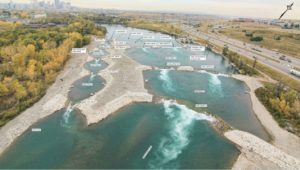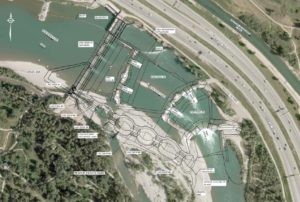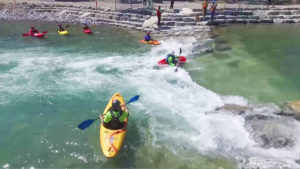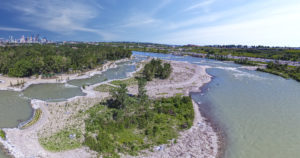Rehabilitation of Harvie Passage After Flood Damage
November 22, 2019 |
If you have ever been to Calgary, Alberta, you have likely seen the Harvie Passage on the Bow River. It was first built in 2011 but was damaged during the flood the city experienced in the summer of 2013. Now rebuilt, Harvie Passage is a wonderful landmark, tourist attraction and a popular recreational area. Here we share lessons learned and how the passage was rehabilitated and blended into the natural surroundings.
Background
The Calgary Bow River Weir, originally constructed in 1908, is on the Bow River 3 km east of downtown Calgary. Prior to Harvie Passage being built in 2011, the weir was a barrier to boaters and fish passage for a 100 km section of the river. Harvie Passage was built to eliminate the extreme drowning hazard at the weir and to enable passage for boats and fish, while maintaining water diversions from the Bow River.
Harvie Passage was designed and constructed between 2006 and 2011 under the direction of Parks Foundation Calgary, The City of Calgary, Alberta Environment and Parks, and Alberta Transportation. Klohn Crippen Berger (KCB), in association with Northwest Hydraulic Consultants and Recreation Engineering and Planning, undertook the final design, contracting, construction contract administration and resident engineering, and post-construction monitoring of the project.
The project, completed on time and on budget, was named Harvie Passage in 2011 in recognition of significant funding from the Harvie family of Calgary. Harvie Passage proved to be a popular recreational boating destination and a place for picnickers, water, and wildlife enthusiasts.
Historic flood of 2013
The unprecedented flood in June 2013 of the Bow and Elbow Rivers resulted in a 1 in 100-year flood discharge and a large influx of sediment through Harvie Passage. The flood caused major infilling, damaged portions of the divide island, and eroded an old river channel. It also lowered downstream river levels, creating unsafe hydraulic conditions. Harvie Passage was closed from 2013 until its rehabilitation in 2018.


Lessons learned from the flood
When Harvie Passage was completed in 2011, it was one of the largest facilities of its kind in North America, with very little precedent in Canada. How it would be used and valued was not fully understood. The project teams observed how the Passage performed, how it was used, and how the public accessed and valued it in the early years of its operation. Based on these observations, the following invaluable “lessons learned” were incorporated into the rehabilitation of Harvie Passage beginning in 2017:
- Areas of boulders, boulder concrete, and vegetated rip-rap were extended in the rehabilitation to reduce erosion around the boulders.
- The new Low Water Channel (LWC) provides more room for the river, reducing sedimentation buildup in the LWC — where it was found to be significant — and where assessments showed it was likely to build during future flood events.
- Underwater maintenance roads were built to allow for maintenance and the periodic removal of sediment and debris.
- A longer, hydraulically diverse channel was placed along the eroded channel, providing much-improved opportunities for canoeing, kayaking, floating, and swimming, while expanding both aquatic and terrestrial habitats.

Harvie Passage Rehabilitation Design and Construction
Following the design approach of the original Harvie Passage, a key goal of the rehabilitation effort was to blend the works with the natural surroundings of the Bow River. This meant using natural construction materials where possible, such as boulders, cobbles, gravels, and riparian vegetation. (Conventional hydraulic designs normally consist of constructed materials, such as reinforced concrete, structural steel, and sheet piles.) To blend into the natural surroundings, erosion-prone areas were protected by placing large boulders and infilling the voids between boulders with fibre-reinforced concrete for structural integrity. The fibre-reinforced concrete prevents trapping people or animals between boulders and is safe for people to walk barefoot on.
KCB led the engineering consulting team listed below and was responsible for project management, design, environmental services, tendering, construction contract administration, and resident engineering:
- SG1 Water Consulting Ltd. provided expert input on hydraulic modelling, recreational hydraulics, safety planning and implementation, and performed post-construction performance evaluations of the whitewater play features.
- Recreation Engineering and Planning provided expert input on the design and performed post-construction performance evaluations of the whitewater play features.
- O2 Planning + Design was responsible for functional planning and landscape design.
- Northwest Hydraulic Consultants was responsible for physical hydraulic and river morphology.
Partnering with our client, Alberta Transportation, the owner, Alberta Environment and Parks, and the contractor, Bluebird Contracting Services - the project was completed on time and under the approved budget. The input, guidance and support of our partners are acknowledged and appreciated.
The rehabilitation of Harvie Passage resulted in a more robust and sustainable facility, with new terrestrial and aquatic habitats seamlessly integrated into the nearby Pearce Estate Park to create a unique recreational amenity for Calgarians and visitors to enjoy.

